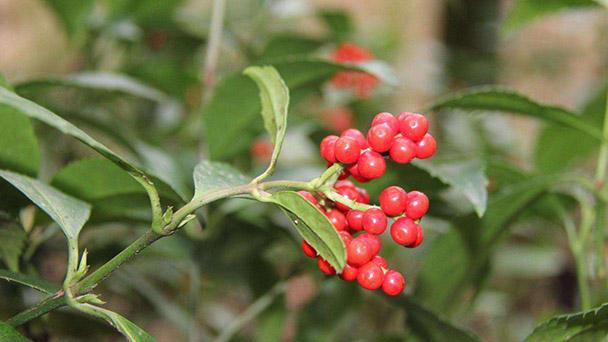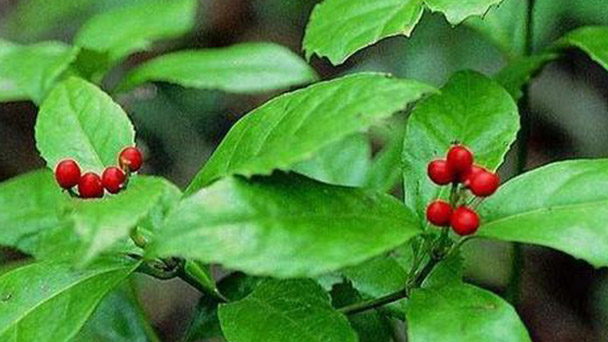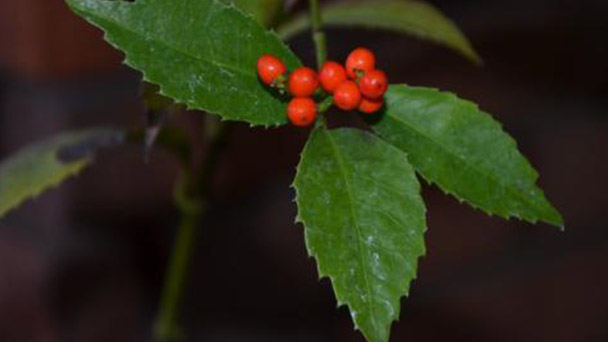How to grow Sarcandra glabra
Written by Maggie
Nov 12 2020

The planting of Sarcandra glabra can grow up to 120cm. Its stems and branches are divided into two sections. Most of its leaves are oval and oval, and they will bear fruit in August to October each year. The fruit of Sarcandra glabra is small, round, and the skin is red. The entire plant of Sarcandra glabra is used as a medicinal material to treat symptoms such as pneumonia.
Sarcandra glabra picture

Sarcandra glabra morphological characteristics
Sarcandra glabra belongs to the golden chestnut orchid family and is often grown as an ornamental potted plant. What does the grass coral look like? Grass coral is an evergreen shrub, the plant can grow up to 120cm, its stems and branches are divided into sections, and the leaves are mostly oval and oval.
Sarcandra glabra blooms in June each year and bears fruit from August to October. Its fruit is round in shape, small in size, and red in color, which can be used for medicinal purposes. sarcandra glabra is suitable for growing in warm and humid environments, they like shade, and are afraid of strong light and high temperature. They are mostly distributed in Zhejiang, Guangdong, Sichuan, Yunnan, Taiwan and other regions.
Sarcandra glabra was a wild plant at first, but was later discovered to be grown as a household plant. The wild environment is very harsh, so sarcandra glabra has strong disease resistance. Sarcandra glabra contains a variety of volatile oils, flavonoids, coumarins, cyanogenic glycosides, lactones and other chemical components, which have certain utilization values.
The whole Sarcandra glabra plant can be used as medicinal materials. It has the effects of clearing heat, detoxifying, promoting blood circulation, relieving pain, and reducing swelling. It can be used to treat symptoms such as influenza, bruises, rheumatism, joint pain, and pneumonia. The combination of grass coral and other medicinal materials can also treat symptoms such as traumatic bleeding, stomach pain, and wound ulceration.
How to cultivate Sarcandra glabra Site selection, site preparationIt is advisable to choose hillside fields, rowing fields or sandy soil areas near ravines and streams and under the shade of valleys with convenient water sources for planting grass coral. Dig the land in autumn and winter to weather it naturally, and prepare the land before planting in the next spring. It is better to choose the plot under the evergreen broad-leaved forest with damp, deep soil and loose texture for the nursery. During land preparation, 2,000 kilograms of fertilizers per acre are applied to farmyard soil and plowed into the soil, harrowed and leveled, and made into a high border with a width of 1 meter.
Reproduction method
1. Cutting propagation
From March to April, select 1-2 year-old branches from robust plants of Sarcandra glabra, cut them into 2-3 knots, 10-15 cm long cuttings, bundle them into small handfuls, and place their base ends in 0.05 ml/liter No. 3 ABT Soak in rooting powder solution for 2-3 minutes, or quickly dipped in 1ml/L NAA solution and then cut. The rooting time of the treated cuttings was significantly shortened, and the survival rate was almost 100{bf}. After the cuttings are processed, in the seedbed prepared in advance, insert the soil obliquely according to the spacing of 5 cm X × 0 cm, leave 1 section on the soil, press tightly, and water thoroughly. If the seed beds of Sarcandra glabra are all small, it is best to set up a shed to keep the seedbeds moist. About 30 days after the cuttings, the cuttings take root and begin to sprout. After survival, care should be taken to loosen the soil and weed, and apply thin human and animal manure water in a timely manner to promote the growth of seedlings. After cultivating for 10-12 months, grass coral can be planted out of the nursery.
2.Seed propagation
When the fruits of Sarcandra glabra are red and ripe from October to December, they are collected and mixed with fine wet sand (seed: wet sand = 1:2, stored in a high dry and ventilated place indoors, or packed in a wooden box and placed in a ventilated place indoors Store the seeds from February to February the next spring for sowing. On the whole seedbed, open a 2-3 cm deep sowing ditch with a row spacing of 20 cm, sow the seeds evenly in the ditch, and cover with fire ash or fine soil , Cover the grass on the border with no seeds, and set up a shade shed. Seedlings emerge about 20 days after sowing, and the cover grass coral should be removed in time. During the seedling period, the soil should be loosened and weeded, and fertilizer should be applied in time.
3. Rectification
In early spring or late fall. Firstly, the aboveground part of the Sarcandra glabra is cut 10 cm away from the ground to be used as medicine or as cutting material, then the roots are dug up, and the stems are divided into small plants with roots, and the planting distance is 20 cm × 30 cm directly in the field. Water continuously after planting to keep the soil moist. Pay attention to weeding and fertilizing after survival. This method is simple, high survival rate, fast plant growth, but low reproduction coefficient.
4. Transplanting
Seedlings and seedlings propagated by cuttings of Sarcandra glabra are generally transplanted from November to December of the current year or from February to February of the following spring. On the whole border, plant the plants at a distance of 20 cm × 30 cm, and irrigate the root water. After survival, field management should be strengthened in time.

Field management
1. Check seedlings and replenish seedlings
Check seedlings of grass coral in time after transplanting. If dead seedlings are found to be missing, bring soil to replant to ensure that the whole seedlings.
2. Intertillage and weeding
Weeds in the field should be cleared in time during the seedling stage, and the soil should be loosened by intertillage. Generally, cultivating 3-4 times a year to keep the soil loose and no weeds in the field for Sarcandra glabra
3. Irrigation and drainage
Always keep the soil moist after planting Sarcandra glabra. In case of drought, irrigate and water in time. In rainy seasons, such as accumulation of water in the field, it should be removed in time to avoid root rot.
4. Top dressing
Generally, top dressing is performed once a year in spring and summer, and 6-7 kg of ammonium nitrate or urea and 2-3 kg of potassium chloride are applied per acre. Combine soil cultivation in winter, apply farmyard manure once, apply fence or retting fertilizer to the rhizosphere of grass coral, and use soil to cover the ditch, which can not only keep warm and cold, but also promote early plant growth and growth in the following spring.
5. Field
Intercropping corn and other high-stalk crops, using high-stalk crops for proper shading. Through the management of intercropping crops, it can not only promote the growth of Sarcandra glabra, but also increase economic income.
Pest control
Sarcandra glabra has just been transformed from wild to domestic species, and has strong resistance to diseases and insects. No serious diseases and insect pests have been found so far, and no control is needed. However, if the shading conditions in the field are poor, and in summer when the sun is strong, leaf burns will occur, leaf tips or leaf greens will appear spotted, and whole leaves will be severely burnt. Measures such as irrigation to cool down and improve shading conditions can be used to reduce damage.
Latest Updated
- Benefits of Bugleweed - 7 Science-backed Health Benefits
- Bugleweed Dangers & Side Effects - Is It Poisonous?
- How to Plant Evergreen Trees - What You Should Know
- When to Plant Evergreens - Grow Guide for Evergreen Trees
- 12 Wonderful Evergreen Shrubs for Your Garden
- 12 Popular Evergreen Plants with Pictures for Beginners
- When And How To Prune A Lilac Bush Like a Pro
- How to Grow & Care for Lilac Vine (Hardenbergia Violacea)
- Japanese Lilac Tree (Syringa Reticulata) Care & Propagation Guide
- Shumard Oak Pros and Cons - What to Know
Popular Articles
- Winter maintenance of Antirrhinum Majus
- How to Grow Terminalia Mantaly Tree
- How to Grow and Care for Crossostephium Chinense
- How to grow Antirrhinum Majus in spring
- Peristeria Elata (Dove Orchid) Profile: Info & Care Guide
- Underwatered Snake Plant (Sansevieria Trifasciata) - Signs And How To Fix
- How to Care for Brazilian Jasmine Plant (Mandevilla Sanderi)
- How to Grow & Care for Graptopetalum Purple Delight in Summer
- Rosa Chinensis (China Rose): Plant Growing & Care Tips
- How to Care for Baby Sun Rose (Aptenia Cordifolia)